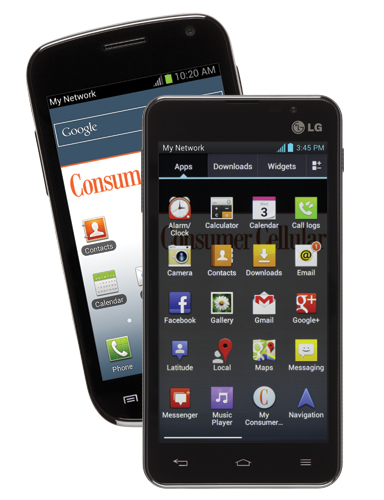 The wireless-communications industry thrives on the latest and the greatest; witness the masses who camp out in front of Apple stores every year or so anticipating the newest iPhone. Consumer Cellular, a Tigard-based wireless service and phone provider, is not one of the trendsetters.
The wireless-communications industry thrives on the latest and the greatest; witness the masses who camp out in front of Apple stores every year or so anticipating the newest iPhone. Consumer Cellular, a Tigard-based wireless service and phone provider, is not one of the trendsetters.
BY LINDA BAKER
 |
// Photo of CEO John Marick by Adam Bacher |
The wireless-communications industry thrives on the latest and the greatest; witness the masses who camp out in front of Apple stores every year or so anticipating the newest iPhone. Consumer Cellular, a Tigard-based wireless service and phone provider, is not one of the trendsetters.
“There are a lot of wireless companies that get really excited about the youth, business users, those early adopters,” says CEO John Marick, 48. “We’re the boring category. We target people who want cellular phones for the safety and convenience.”
Most of those people are seniors. Founded in 1995, Consumer Cellular has carved out a niche targeting older users with simple, inexpensive and no-contract cell phone plans — with basic service starting at $10 a month. The company grossed about $263 million last year, up from $44.6 million in 2007.
Almost 20 years after Marick and co-founder Greg Pryor identified a void in the marketplace — “the cell phone was a luxury item then; nobody was trying to make it affordable,” Marick observes — Consumer Cellular is growing strong yet faces a few challenges ahead. More competitors are entering the low-cost wireless space. Plus, Consumer Cellular’s target market, the over-50 set, is becoming increasingly tech savvy, “making it harder for us to get our message out,” Marick says.
To stay competitive, Consumer Cellular is setting its sights on an initiative that might seem a contradiction in terms: adapting the ultimate tech status symbol for customers who care little about tech or status. That device would be the smartphone, a product Marick says “could be our next big thing.”
| Consumer Cellular |
| CEO: John Marick |
| Employees: 800 |
| Headquarters: Tigard |
| Factoid: In 2012, Consumer Cellular subscribers used a total of 1,920,845,339 talk minutes |
Consumer Cellular — which employs about 800 people, including Marick’s wife, Tami, and sister, Jill Leonetti (both are part of the management team) — has enjoyed its share of next big things. During its first 10 years, the company focused almost exclusively on the Oregon market. That changed in 2005, when Consumer Cellular signed an agreement with AT&T to buy and resell space on the wireless conglomerate’s network. “That’s what really made us a true national player,” Marick says.
In 2009 the company forged a partnership with another big player, the AARP, giving Consumer Cellular a direct line to the association’s 40 million members. That relationship helped grow the company’s customer count from about 30,000 in 2006 to more than 1 million today.
 |
// Photo courtesy Consumer Cellular |
Another milestone occurred in 2010-11, when Consumer Cellular finalized partnerships with Sears and RadioShack, gaining access to the retail market. And this past August, the company opened a call center in Redmond that employs more than 200 people. About 300 people work at another call center in Phoenix.
About that smartphone push: The (smartphone) name itself is a bit of an obstacle for a company targeting a certain kind of Luddite, Marick admits. But Consumer Cellular is pressing ahead, selling phones stripped of apps along with plans emphasizing affordability and flexibility. “We treat it as a regular phone,” says Marick. “You want our $2.50-per-month data plan, you get it.”
The strategy appears to be working. Last year Consumer Cellular sold only a few smartphones. But during a single week this past May, smartphone sales accounted for 32% of phones shipped from the company warehouse. Consumer Cellular has sold an entry-level smartphone for a couple of years, but this past spring they released two more: the Samsung Galaxy Exhilarate and the LG 930. “Those have really taken off,” Marick says.
Targeted advertising is helping spread the message. Consumer Cellular’s (exclusively) national marketing campaigns target publications and cable television networks favored by retirees, including TV Land and the Game Show Network. Those retirees, whose numbers are on the rise, are helping fuel the company’s 30% annual growth rate. Marick also credits the company’s award-winning customer service — Consumer Cellular has been ranked the No. 1 wireless carrier in a Consumer Reports survey for the past three years — and a prudent approach to financing. “We’re privately held; we have no long-term debt, and our focus is reinvesting everything back in the business.”
The company’s corporate culture is equally close to the vest. The management team vacations together, the CIO and head of equipment and distribution have been with Consumer Cellular for about 17 years, and much of the strategic planning takes place on a “back deck with beer,” Marick says. “You see a lot of startup groups like that, not companies that are 18 years old. Even as we’ve gotten quite large, we still think of ourselves as a small business.”
Of course, balancing, and synthesizing, opposites is standard practice for a company that sells technology to the tech-averse and targets a niche market that, increasingly, is no longer niche. “People say, ‘Oh, you’re going after seniors, so all your customers must be in Florida, Palm Springs,’” says Marick. “But lo and behold: There are seniors everywhere.”


